作者:敲代码の流川枫
博客主页:流川枫的博客
专栏:C语言从入门到进阶
语录:Stay hungry stay foolish
工欲善其事必先利其器,给大家介绍一款超牛的斩获大厂offer利器——牛客网
点击免费注册和我一起刷题吧
1. 为什么存在动态内存
我们经常用到的开辟内存方式有:
int a = 40;
int arr[40] = {0};
上述开辟内存方式的特点:
1.开辟空间的大小是固定的
2.数组在申明的时候,必须指定数组的长度,它所需要的内存在编译时分配
有时候我们需要的空间大小是在程序运行时才能知道,上述方式满足不了要求,所以出现了动态内存的开辟
2. 分配动态内存函数的介绍
2.1 malloc
C语言提供了一个动态内存开辟的函数:
void* malloc (size_t size);
这个函数向内存申请一块连续可用的空间,并返回指向这块空间的指针
如果开辟成功,则返回一个指向开辟好空间的指针
如果开辟失败,则返回一个NULL指针,因此malloc的返回值一定要做检查
返回值的类型是void*,所以malloc函数并不知道开辟空间的类型,具体在使用的时候使用者自己来决定
如果参数size为0,malloc的行为是标准是未定义的,取决于编译器
#define _CRT_SECURE_NO_WARNINGS
#include<stdio.h>
#include<stdlib.h>
#include<string.h>
#include<errno.h>
int main()
{
int arr[10] = { 0 };
//动态内存开辟
int* p = (int*)malloc(40);
if (p == NULL)
{
printf("%s\n", strerror(errno));
return 1;
}
//使用
int i = 0;
for (i=0;i<10;i++)
{
*(p + i) = i;
}
for (i = 0; i < 10; i++)
{
printf("%d ", *(p + i));
}
printf("\n");
return 0;
}

这里没有free,当程序退出的时候, 系统会回收该空间
2.2 free
C语言提供了另外一个函数free,专门是用来做动态内存的释放和回收的,函数原型如下:
void free (void* ptr);
free函数用来释放动态开辟的内存
如果参数ptr指向的空间不是动态开辟的,那free函数的行为是未定义的
如果参数ptr是NULL指针,则函数什么事都不做
malloc和free都声明在stdlib.h头文件中
int main()
{
int arr[10] = { 0 };
//动态内存开辟
int* p = (int*)malloc(40);
if (p == NULL)
{
printf("%s\n", strerror(errno));
return 1;
}
//使用
int i = 0;
for (i=0;i<10;i++)
{
*(p + i) = i;
}
for (i = 0; i < 10; i++)
{
printf("%d", *(p + i));
}
//释放
free(p);
p = NULL;
return 0;
}
不用free函数释放空间会出现内存泄漏,free回收完系统空间时,p还是指向那块吧被释放的空间,为了避免出现野指针的问题,一定要将它置为空指针
2.3 calloc
C语言还提供了一个函数叫calloc,calloc函数也用来动态内存分配。原型如下:
void* calloc (size_t num, size_t size);
函数的功能是为num个大小为size的元素开辟一块空间,并且把空间的每个字节初始化为0
与函数malloc的区别只在于calloc会在返回地址之前把申请的空间的每个字节初始化为全0
#define _CRT_SECURE_NO_WARNINGS
#include<stdio.h>
#include<stdlib.h>
#include<string.h>
#include<errno.h>
int main()
{
int arr[10] = { 0 };
//动态内存开辟
int* p = (int*)calloc(10,sizeof(int));
if (p == NULL)
{
printf("%s\n", strerror(errno));
return 1;
}
//使用
/*int i = 0;
for (i=0;i<10;i++)
{
*(p + i) = i;
}*/
int i = 0;
for (i = 0; i < 10; i++)
{
printf("%d ", *(p + i));
}
printf("\n");
free(p);
p = NULL;
return 0;
}

所以如何我们对申请的内存空间的内容要求初始化,那么可以很方便的使用calloc函数来完成任务
2.4 realloc
realloc函数的出现让动态内存管理更加灵活
有时会我们发现过去申请的空间太小了,有时候我们又会觉得申请的空间过大了,那为了合理的时候内存,我们一定会对内存的大小做灵活的调整。那realloc函数就可以做到对动态开辟内存大小的调整。函数原型如下:
void* realloc (void* ptr, size_t size);
ptr是要调整的内存地址
size调整之后新大小
返回值为调整之后的内存起始位置
这个函数调整原内存空间大小的基础上,还会将原来内存中的数据移动到新的空间
realloc在调整内存空间的是存在两种情况:
情况1:
当是情况1 的时候,原有空间之后没有足够多的空间时,扩展的方法是:在堆空间上另找一个合适大小的连续空间来使用。这样函数返回的是一个新的内存地址,旧的地址和数据都会被自动释放
情况2:
当是情况2 的时候,要扩展内存就直接原有内存之后直接追加空间,原来空间的数据不发生变化
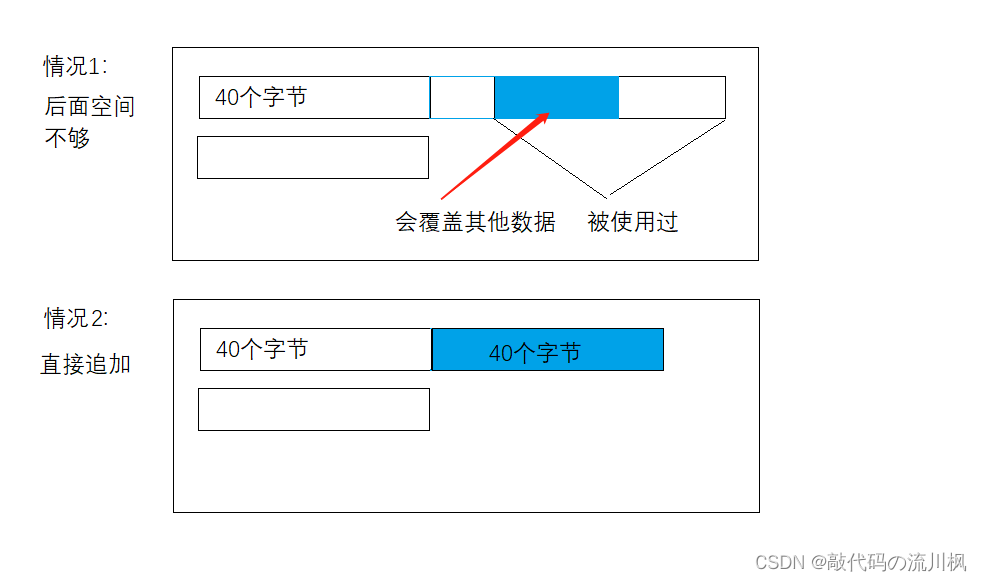
#define _CRT_SECURE_NO_WARNINGS
#include<stdio.h>
#include<stdlib.h>
#include<string.h>
#include<errno.h>
int main()
{
int arr[10] = { 0 };
//动态内存开辟
int* p = (int*)malloc(40);
if (p == NULL)
{
printf("%s\n", strerror(errno));
return 1;
}
//使用
int i = 0;
for (i=0;i<10;i++)
{
*(p + i) = i+1;
}
//扩容
//追加40个字节
int *ptr = (int* )realloc(p, 80);
if (ptr != NULL)
{
p = ptr;
}
//使用
for (i = 0; i < 10; i++)
{
printf("%d ", *(p + i));
}
printf("\n");
free(p);
p = NULL;
return 0;
}
**注意:开辟多了会出现内存碎片,导致内存利用率下降,程序的效率也会下降 **
3. 常见的动态内存错误
3.1 对NULL指针的解引用操作
int main()
{
int* p = (int*)malloc(40);
if (p == NULL)
{
return 1;
}
*p = 20;
free(p);
p = NULL;
return 0;
}
要判断是否为空指针,如果是空指针就是开辟内存失败,出现对空指针的解引用
3.2 对动态开辟空间的越界访问
int main()
{
int* p = (int*)malloc(40);
if (p == NULL)
{
printf("%s", strerror(errno));
}
int i = 0;
for (i = 0; i <= 10; i++)
{
p[i] = i;
}
free(p);
p = NULL;
return 0;
}

当i是10的时候越界访问
3.3 对非动态开辟内存使用free释放
void test()
{
int a = 10;
int* p = &a;
free(p);
p = NULL;
}
int main()
{
test();
return 0;
}
free函数只能对在堆上开辟的动态内存进行释放
3.4 使用free释放一块动态开辟内存的一部分
int main()
{
int* p = (int*)malloc(40);
if (p == NULL)
{
printf("%s", strerror(errno));
}
int i = 0;
for (i = 0; i <= 10; i++)
{
*p = i;
p++;
}
//释放
free(p);
p = NULL;
return 0;
}

程序运行起来,p已经不指向最开始的地址,因此最后释放,也不会将动态开辟的内存全部释放
3.5 对同一块动态内存多次释放
int main()
{
int* p = (int*)malloc(40);
free(p);
//.....
free(p);
return 0;
}
重复释放并且没有将p置为空指针,会报错
3.6 动态开辟内存忘记释放(内存泄漏)
void test()
{
int* p = (int*)malloc(40);
//....
int a = 0;
scanf("%d", &a);
//...
if (a == 10)
return;
free(p);
p == NULL;
}
int main()
{
test();
return 0;
}
当满足a==10,free是没有机会被执行的,并且函数结束就找不到该空间的地址了,也不会释放,内存出现泄漏
注意:忘记释放不再使用的动态开辟的空间会造成内存泄漏
动态开辟的空间一定要释放,并且正确释放
4. 几个经典的笔试题
运行Test 函数会有什么样的结果
笔试题1
void GetMemory(char* p)
{
p= (char*)malloc(100);
}
void Test(void)
{
char* str = NULL;
GetMemory(str);
strcpy(str, "hello world");
printf(str);
}
解析:
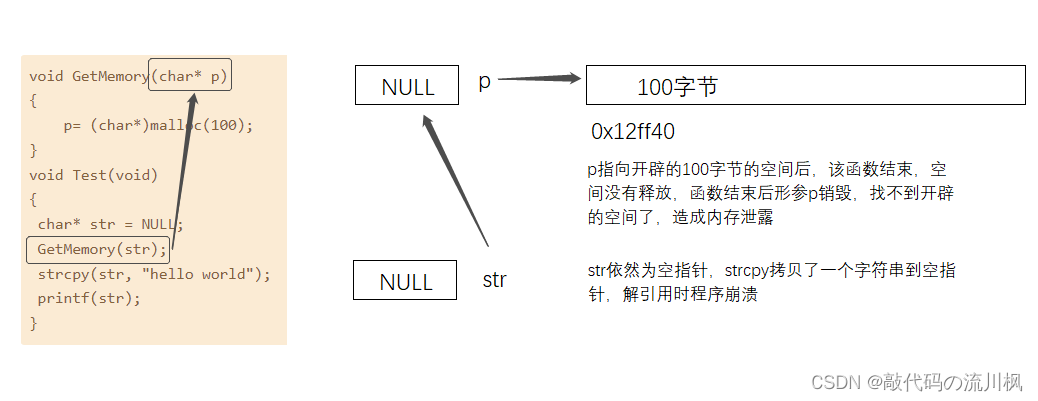
笔试题2
char* GetMemory(void)
{
char p[] = "hello world";
return p;
}
void Test(void)
{
char*str = NULL;
str = GetMemory();
printf(str);
}
解析:
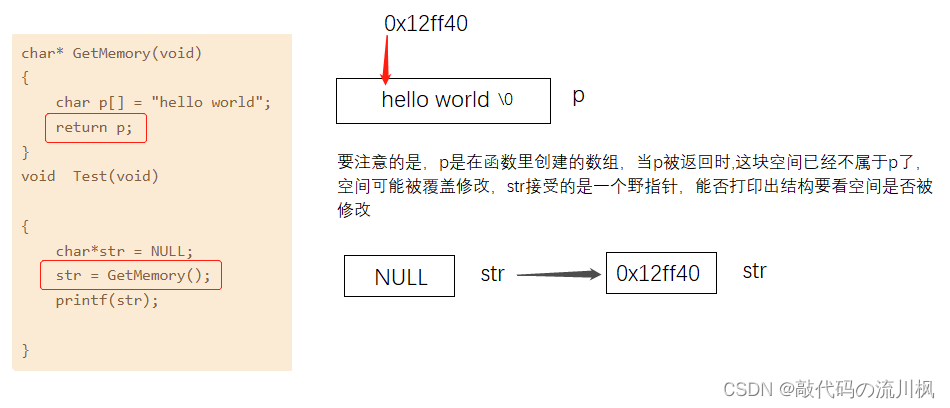
笔试题3
void GetMemory(char** p, int num)
{
*p= (char*)malloc(num);
}
void Test(void)
{
char* str = NULL;
GetMemory(&str, 100);
strcpy(str, "hello");
printf(str);
}
分析:

笔试题4
void Test(void)
{
char* str = (char*) malloc(100);
strcpy(str, "hello");
free(str);
if(str != NULL)
{
strcpy(str,"world");
printf(str);
}
}
分析:
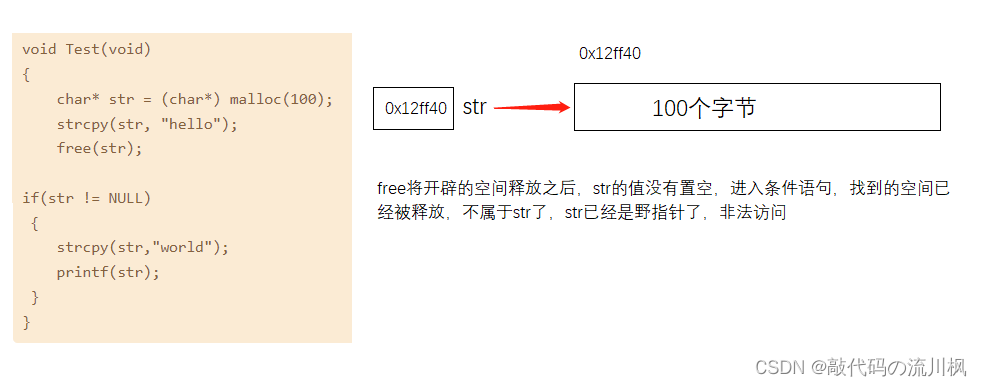
5. C/C++程序的内存开辟
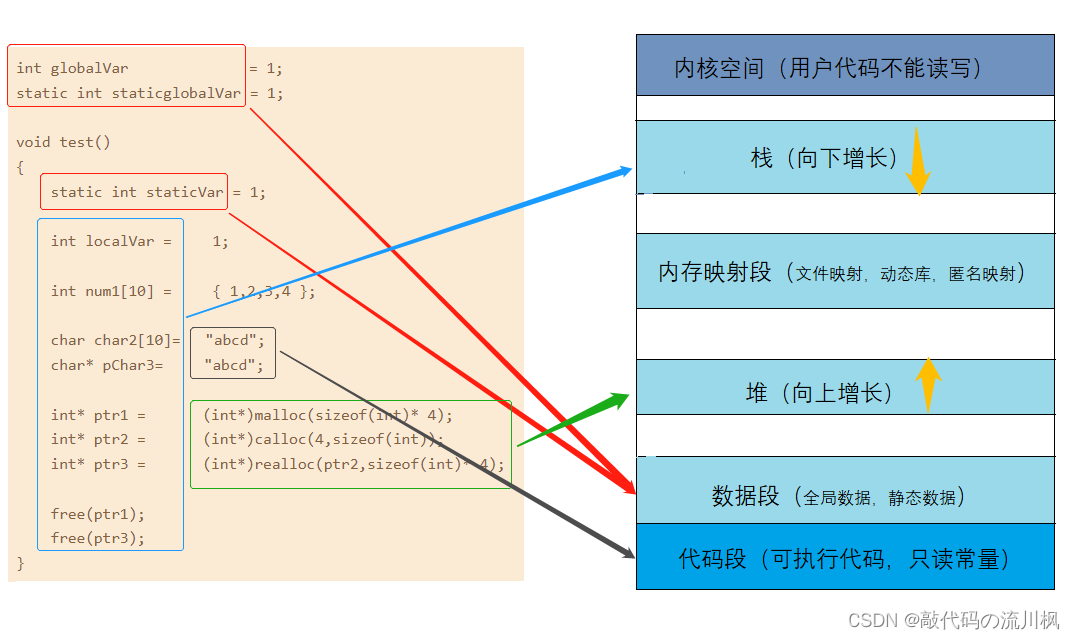
6. 动态通讯录
动态通讯录:默认存放三个人的信息,不够则扩容,每次增加两个人的空间,在静态通讯录的基础上修改即可
参看静态通讯录
#pragma once
#include<stdio.h>
#include<string.h>
#include<assert.h>
#include<stdlib.h>
#define MAX 100
#define MAX_NAME 20
#define MAX_SEX 10
#define MAX_TELE 12
#define MAX_ADDR 30
#define DEFAULT_Sz 3
#define INC_SZ 2
//类型的声明
//
//只是一个人的信息
typedef struct PeoInfo
{
char name[MAX_NAME];
int age;
char sex[MAX_SEX];
char tele[MAX_TELE];
char addr[MAX_ADDR];
}PeoInfo;
//静态版本
通讯录(多个人的信息)
//typedef struct Contact
//{
// PeoInfo data[100];//存放人的信息
// int count;//记录当前通讯录有多少人的信息
//}Contact;
//
//
//动态版本
typedef struct Contact
{
PeoInfo* data;//存放人的信息
int count;//记录当前通讯录有多少人的信息
int capacity;//记录当前通讯录容量
}Contact;
//初始化通讯录函数
int InitContact(Contact *pc);
//增加联系人到通讯录
void addContact(Contact* pc);
//打印通讯录信息
void showContact(const Contact* pc);
//删除指定联系人
void delContact(Contact* pc);
//查找指定联系人
void SearchContact(Contact* pc);
//修改指定联系人
void modifyContact(Contact* pc);
//按照名字排序通讯录内容
void sortContact(Contact* pc);
//销毁通讯录
void DestroyContact(Contact* pc);
//动态版本
int InitContact(Contact* pc)
{
pc->count = 0;
pc->data = (PeoInfo*)calloc(DEFAULT_Sz,sizeof(PeoInfo));
if (pc->data == NULL)
{
printf("InitContact:%s\n", strerror(errno));
return 1;
}
pc->capacity = DEFAULT_Sz;
return 0;
}
实现增容功能:
//增容函数
void CheckCapacity(Contact* pc)
{
if (pc->count == pc->capacity)
{
PeoInfo* ptr = (PeoInfo*)realloc(pc->data, (pc->capacity + INC_SZ) * sizeof(PeoInfo));
if (ptr == NULL)
{
printf("addContact:%s\n", strerror(errno));
}
else
{
pc->data = ptr;
pc->capacity += INC_SZ;
printf("增容成功\n");
}
}
}
//动态版本
void addContact(Contact* pc)
{
assert(pc);
//增容
CheckCapacity(pc);
//添加信息
printf("\n请输入名字:>");
//每次放进去的信息都是放进data 下标为count的数组
scanf("%s", pc->data[pc->count].name);
printf("\n请输入年龄:>");
//因为name是存放在数组中,数组名本身就是地址,不需要再取地址
//这里的年龄是int 型变量,需要取地址
scanf("%d", &(pc->data[pc->count].age));
printf("\n请输入性别:>");
scanf("%s", pc->data[pc->count].sex);
printf("\n请输入电话:>");
scanf("%s", pc->data[pc->count].tele);
printf("\n请输入地址:>");
scanf("%s", pc->data[pc->count].addr);
pc->count++;
printf("\n增加成功\n");
}
free增容所开辟的空间:
//销毁通讯录
void DestroyContact(Contact* pc)
{
assert(pc);
free(pc->data);
pc->data = NULL;
}
** “ 本期的分享就到这里了, 记得给博主一个三连哈,你的支持是我创作的最大动力!”**
版权归原作者 敲代码の流川枫 所有, 如有侵权,请联系我们删除。